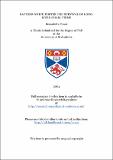Files in this item
Factors which foster the survival of long-lived small firms
Item metadata
| dc.contributor.advisor | Reid, Gavin C. | |
| dc.contributor.author | Power, Bernadette | |
| dc.coverage.spatial | 557 p. | en_US |
| dc.date.accessioned | 2018-06-15T11:57:17Z | |
| dc.date.available | 2018-06-15T11:57:17Z | |
| dc.date.issued | 2004 | |
| dc.identifier.uri | https://hdl.handle.net/10023/14113 | |
| dc.description.abstract | This thesis focuses on those factors which foster the long-run survival, or continued existence, of the small firm. Using fieldwork methods, new data were gathered in face-to-face interviews with 63 owner-managers of mature small firms in Scotland (average age of 251/2 years). An instrument incorporating novel ways of calibrating organisational change and performance was designed specifically for this study. The unique body of data enabled a number of new hypotheses to be tested in structural econometric models of small firm performance and growth. A mix of quantitative and qualitative data was also used to construct illustrative case studies of seven enterprise profiles. New measures of flexibility and firm-specific turbulence are used to explain the performance of mature small firms, and Heckman sample selection estimation is undertaken of this performance equation. Performance was measured using an index constructed fi-om Likert scales over 28 distinct attributes. It was found that firm- specific turbulence had a large negative effect on performance. Measures of flexibility (viz. agility and speed) enhanced the long run prospects of the mature small firm. Evidence of a trade-off relationship was found between measures of flexibility. Real options logic was found to be useful in interpreting the results. This evidence indicated that entrepreneurs should be alert to precipitators of organisational change, but should not act impulsively in responding to them. The tendency of the long-lived small firm to remain small is considered using structural modelling techniques. In a three-equation simultaneous model, performance, size and a third variable (viz. market extent and size of competitive strategy space) are jointly determined. An array of system estimation techniques (e.g. 2SLS, SSLS, H3SLS) was employed to estimate the behavioural models. A trade-off is found between firm size and performance, thus embedding this result in a larger structural model. It is found that small firms need to adjust downwards in size, and to cultivate a varied competitive strategy in niche or localised markets, to attain higher equilibrium values of performance and to promote longevity. | en_US |
| dc.language.iso | en | en_US |
| dc.publisher | University of St Andrews | |
| dc.subject.lcc | HD2346.G7P7 | |
| dc.subject.lcsh | Small business--Scotland | en |
| dc.subject.lcsh | Small business--Econometric models | en |
| dc.subject.lcsh | Small business--Management | en |
| dc.title | Factors which foster the survival of long-lived small firms | en_US |
| dc.type | Thesis | en_US |
| dc.type.qualificationlevel | Doctoral | en_US |
| dc.type.qualificationname | PhD Doctor of Philosophy | en_US |
| dc.publisher.institution | The University of St Andrews | en_US |
This item appears in the following Collection(s)
Items in the St Andrews Research Repository are protected by copyright, with all rights reserved, unless otherwise indicated.

